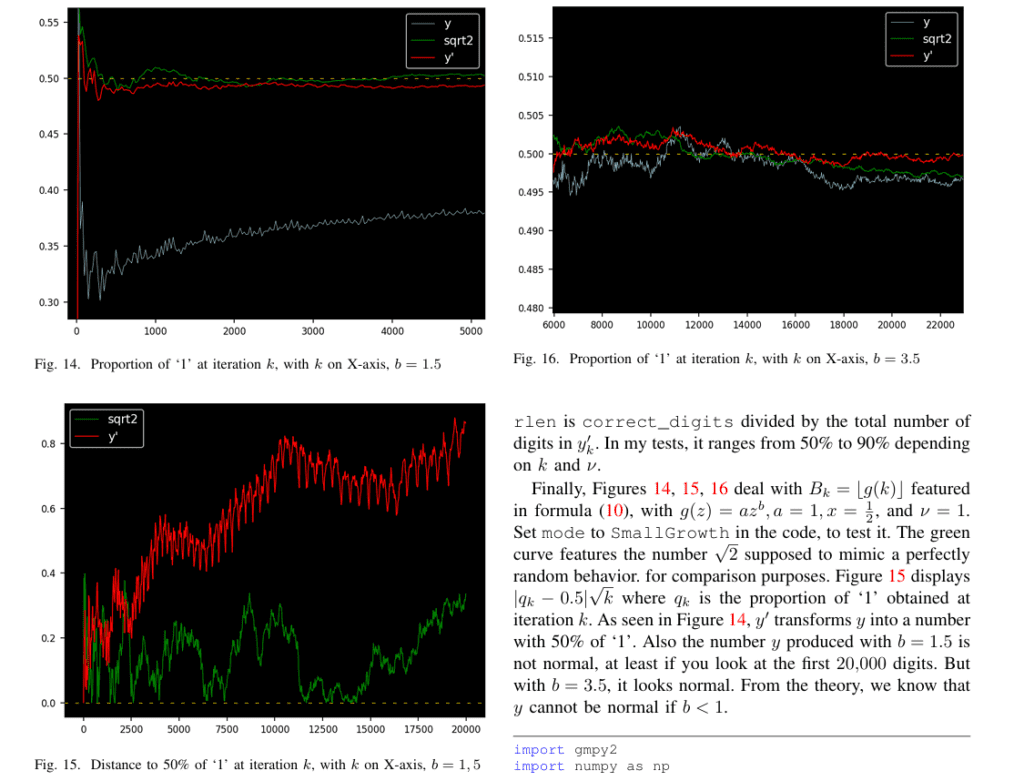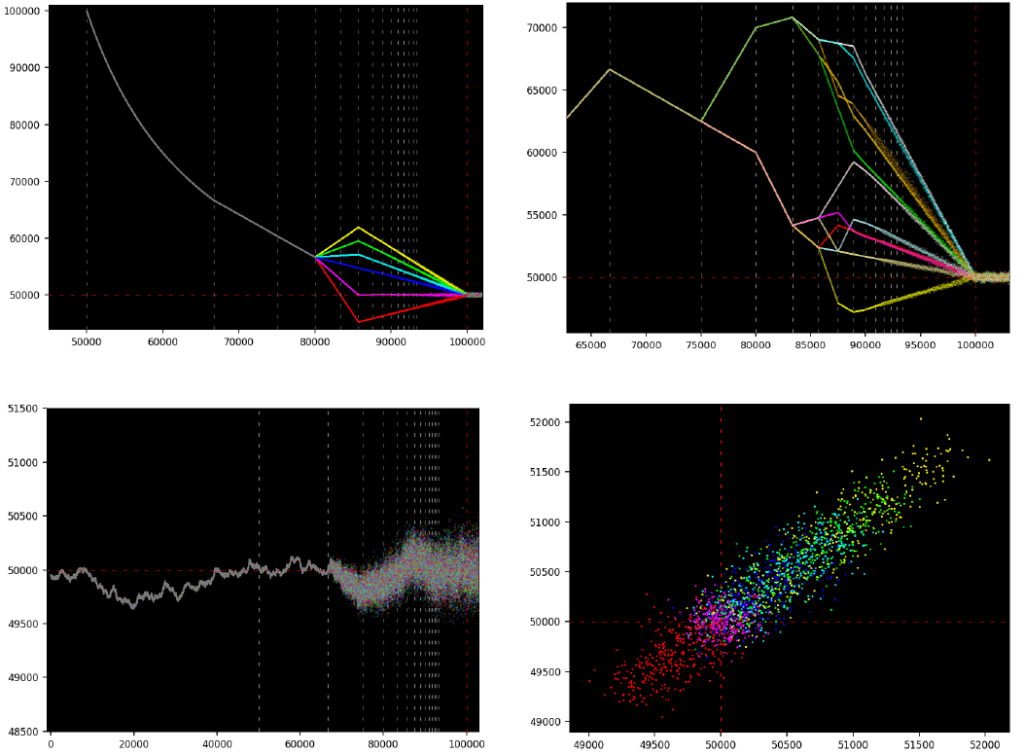This book opens up new research areas in theoretical and computational number theory, numerical approximation, dynamical systems, quantum dynamics, and the physics of numbers. With a strong emphasis on applications:
- Pattern detection and theorem proving with AI,
- Building a bias-free, universal synthetic dataset,
- Computer intensive simulations such as agent-based modeling, with scientific programming,
- Building a universal bias-free pattern-rich synthetic dataset,
- Cryptography: fast, strong random number generators relying on irrational numbers,
- Dynamical systems with chaos detection and isolation,
- High-performance computing to handle massive numbers such as 2n+1 at power 2n with n = 106,
- Quantum models and numerical precision with potential applications to Fintech.
Each chapter is self-contained. You can read them in random order. I present them in chronological order. The last one features the most recent research and discoveries. The first one is more technical, focusing on the foundations; you can skip it initially if your main interest is in the applications.
Target audience
Written in simple English, jargon free, even when covering advanced topics. With enterprise-grade Python code along with efficient algorithms not taught in any classroom or textbook. To benefit from the material, you need beginner experience with Python, and the equivalent of a first-year college course on calculus. The book is targeted to professionals in AI, machine learning, engineering, physics, scientific computing, operations research, computer science, and Fintech. Students with an analytical mindset will discover original, useful material to enhance their creativity, learning experience, while gaining strong exposure to professional code and applications.

Background story: cracking a deep mathematical mystery
It all started with the number 1. This e-book offers a trip deep into the most elusive and fascinating multi-century old conjecture in number theory: are the binary digits of the fundamental math constants evenly distributed? No one even knows if the proportions of ‘0’ and ‘1’ exist, for any of them: it could oscillate indefinitely between 0% and 100%.
After a quick read, you might believe that I solved it. Yet very smooth functions visibly converging to the intuitive 50% ratio, time after time, are all but smoke and mirrors for the experienced practitioner. They can exhibit surprising, large singularities in extremely rare cases. If you look at the smoothed curves in the book with a microscope, there is still a bit of lingering randomness. Even after using powerful techniques to isolate, explain or remove the chaos. Throughout this book, I guide the reader, warning about these caveats and dead ends while pointing to promising directions to work on the conjecture.
My novel approach sets a clear path towards solving the problem, for the first time ever. Building on solid foundations spanning across multiple disciplines, I share a number of spectacular victories along the way. For instance, this new and counter-intuitive result: all numbers that can be written as
\frac{a_1}{2^1}+\frac{a_2}{2^2}+\frac{a_3}{2^3}+\cdotswhere (an) is an increasing sequence of positive integers with sub-linear growth rate, have a proportion of ‘1’ equal to zero in their infinite binary digit expansion.
Contents
1. Cracking a Famous Multi-century Old Math Conjecture
. . . A new type of string operators
. . . . . . String class
. . . . . . Truncation, number representation, and convergence
. . . . . . String convolution and square root
. . . . . . Well-balanced strings
. . . Infinite sequences of iterated auto-convoluted strings
. . . . . . Visualizing iterated auto-convoluted string sequences
. . . . . . Fundamental result about the number of zeros and ones
. . . Solving one of the greatest mathematical mysteries
. . . . . . Testing different seeds
. . . . . . Another interesting sequence
. . . . . . Surprising, unpublished results about the digit distribution
. . . Application to cryptography
. . . Python code
2. LLM Challenge with Petabytes of Data to Prove Famous Number Theory Conjecture
. . . Introduction
. . . Spectacular behavior of the digit sum function
. . . . . . Potential scenarios
. . . . . . Dynamics of the unbroken bifurcation process
. . . Case studies
. . . An extreme case
. . . Applications and AI Challenge with petabytes dataset
. . . . . . AI challenge
. . . . . . The dataset
. . . Python code
3. A Universal Dataset to Test, Enhance and Benchmark AI Algorithms
. . . Introduction
. . . Deep dive into the digit sum function
. . . . . . Digit sum function: examples
. . . . . . Spectacular behavior of digit sum with primorials
. . . . . . Future research
. . . . . . References
. . . . . . Comparison with standard methodology
. . . Infinite dataset and applications
. . . Python code
. . . . . . Forward iterations
. . . . . . Backward iterations
4. Quantum Dynamics, Logistic Map, and Digit Distribution of Special Math Constants
. . . Introduction
. . . Logistic map and the digit sum function
. . . . . . Model comparison, with illustrations
. . . . . . Normality of special math constants
. . . . . . Applications and references
. . . Re-balancing an uneven digit distribution
. . . . . . Digit-balancing transforms
. . . . . . Digit block balancing
. . . Conclusion
. . . Main Python code
Bibliography
Index
How do I get my copy?
The 56-page book by Vincent Granville is available here. Publication date: May 2025.

About the Author

Vincent Granville is a pioneering GenAI scientist, co-founder at BondingAI.io, the LLM 2.0 platform for hallucination-free, secure, in-house, lightning-fast Enterprise AI at scale with zero weight and no GPU. He is also author (Elsevier, Wiley), publisher, and successful entrepreneur with multi-million-dollar exit. Vincent’s past corporate experience includes Visa, Wells Fargo, eBay, NBC, Microsoft, and CNET. He completed a post-doc in computational statistics at University of Cambridge.

when where is the book hard-copy or PDF available and price.